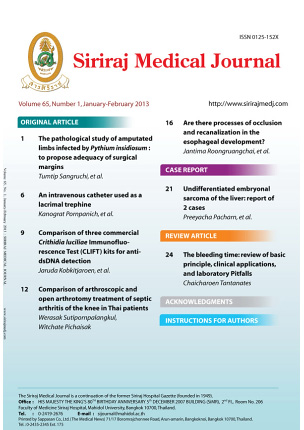The Bleeding Time: Review of Basic Principle, Clinical Applications, and Laboratory Pitfalls
Keywords:
Bleeding time, Clinical applications, PitfallsAbstract
The bleeding time is one of the oldest tests for primary hemostasis which is still performed nowadays.This test
evaluates mainly the primary hemostatic function. Some preanalytical variables including patients’ physiology and hematological
status may impact test results. Various protocols of bleeding time are performed. Each method has pros and cons,
although the template bleeding time is currently preferred over other methods because it is well-standardized. Interpretation
of the results according to a well-established reference range is important. At the moment, indications of bleeding time are
very limited due to its poor sensitivity and reproducibility. More sensitive and specific assays have been developed for the
diagnosis of specific conditions. However bleeding time is still useful in uremic patients. A cautionary note - this test should
not be used as a screening test for prediction of bleeding preoperatively.
Downloads
Published
How to Cite
Issue
Section
License
Authors who publish with this journal agree to the following conditions:
Copyright Transfer
In submitting a manuscript, the authors acknowledge that the work will become the copyrighted property of Siriraj Medical Journal upon publication.
License
Articles are licensed under a Creative Commons Attribution-NonCommercial-NoDerivatives 4.0 International License (CC BY-NC-ND 4.0). This license allows for the sharing of the work for non-commercial purposes with proper attribution to the authors and the journal. However, it does not permit modifications or the creation of derivative works.
Sharing and Access
Authors are encouraged to share their article on their personal or institutional websites and through other non-commercial platforms. Doing so can increase readership and citations.











